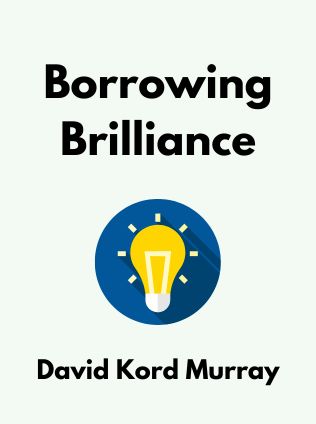
Borrowing Brilliance
The Six Steps to Business Innovation by Building on the Ideas of Others
By David Kord Murray
Published 09/2009
About the Author
David Kord Murray began his career as an aerospace engineer, working on the conceptual development team for the International Space Station. With a background that merges the precision of engineering with the creativity needed for innovation, Murray has worn many hats, including those of an entrepreneur, inventor, and executive at Fortune 500 companies. His role as the head of innovation for the software company Intuit exemplifies his ability to drive forward-thinking strategies in a competitive business landscape. Murray’s diverse experiences have provided him with a unique perspective on the process of idea generation and innovation, culminating in his book, Borrowing Brilliance: The Six Steps to Business Innovation by Building on the Ideas of Others. He currently resides in Tahoe City, California.
Main Idea
The central premise of Borrowing Brilliance is that no idea is born in isolation. Murray posits that all great ideas are derived from pre-existing concepts and that the process of innovation is inherently about borrowing and building upon these ideas. He introduces a six-step methodology that guides individuals and organizations through the process of creating innovative solutions by leveraging existing ideas. This approach challenges the conventional notion of originality, suggesting instead that the evolution and combination of ideas from various sources is the true driver of innovation.
Table of Contents
- Introduction: The Myth of Originality
- Step 1: Define – Identifying the Problem
- Step 2: Borrow – Finding Existing Ideas
- Step 3: Combine – Merging Ideas
- Step 4: Incubate – Letting Ideas Mature
- Step 5: Judge – Evaluating the Ideas
- Step 6: Enhance – Improving the Ideas
- Conclusion: The Future of Innovation
- Appendix: Suggested Reading
Analyzing and Explaining Each Idea
Introduction: The Myth of Originality
In the introduction, Murray debunks the myth that original ideas are created from nothing. He asserts that creativity and innovation are more about the transformation and adaptation of existing ideas than the creation of entirely new ones. He illustrates this with examples from various fields, highlighting that even the most groundbreaking innovations have roots in prior knowledge and concepts.
“There’s no such thing as an original idea. There are only original combinations.” – David Kord Murray
Murray emphasizes that acknowledging the borrowed nature of ideas does not diminish their value but rather opens up endless possibilities for innovation. By understanding and embracing this concept, individuals and organizations can become more effective in their creative endeavors.
Step 1: Define – Identifying the Problem
The first step in Murray’s process is to clearly define the problem that needs to be solved. This involves understanding the core issue and its context, which sets the stage for finding relevant ideas to borrow. Murray stresses the importance of a well-defined problem as the foundation of the innovation process.
To illustrate this point, Murray recounts his experience at Intuit, where he faced a direct marketing problem. By thoroughly defining the problem, he was able to identify key areas where existing ideas could be applied.
“Define the problem clearly, and the solution will often present itself.” – David Kord Murray
defining problems include:
- Identifying customer pain points in a product
- Analyzing operational inefficiencies within a company
- Understanding market trends that impact business strategy
Step 2: Borrow – Finding Existing Ideas
The second step is about sourcing existing ideas that can address the defined problem. Murray encourages looking beyond one’s industry to find inspiration. He uses the metaphor of piracy to describe this process, likening innovators to pirates who borrow ideas from various sources, including competitors and unrelated fields.
Murray provides examples from the tech industry, particularly the early days of personal computing, where companies like Microsoft and Apple borrowed ideas from each other and other industries to drive innovation.
“Great innovators are often the best borrowers.” – David Kord Murray
Key sources for borrowing ideas include:
- Competitor analysis
- Cross-industry case studies
- Historical innovations
Step 3: Combine – Merging Ideas
In this step, Murray discusses the importance of combining borrowed ideas to create something new. He explains that the most innovative solutions often result from the synthesis of multiple concepts. This step involves creativity and critical thinking to merge disparate ideas into a cohesive solution.
Sign up for FREE and get access to 1,400+ books summaries.
You May Also Like
The Lean Startup
How Today's Entrepreneurs Use Continuous Innovation to Create Radically Successful Businesses
By Eric RiesWho Moved My Cheese?
An Amazing Way to Deal with Change in Your Work and in Your Life
By Spencer Johnson, M.D.Make Your Bed
Little Things That Can Change Your Life...And Maybe the World
By William H. McRavenThe Ride of a Lifetime
Lessons Learned from 15 Years as CEO of the Walt Disney Company
By Robert Iger



















